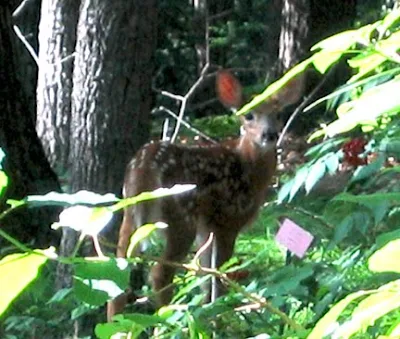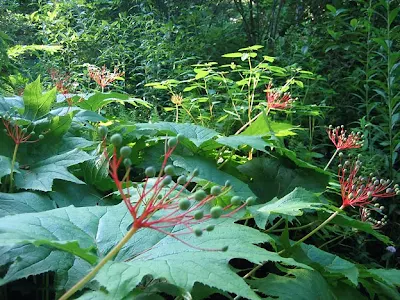New England Wildflower Society
The Garden in the Woods actually contains a number of gardens, linked by trails that can be somewhat confusing to navigate -but we figured it out along the way (we had a map). There are also woodland trails not part of the garden proper, but connected to it. I saw many plants in flower, all quite beautiful, but it has taken much too long to put this post together, and so will give my best impression of brief.
Many of the plants were tagged, and there were different opportunities to learn what one is looking at. For instance, the "What's Blooming Now" sign board at the trail's beginning, but you can't take that with you, and the garden couldn't possibly tag every plant specimen, so it is that I have not identified many of the plants I found interesting. That said, I will try to find them on the internet. I should also point out that the NEWS website goes pretty deep, with a lot of information should you want to find information about particular native plants.
 After parking, you approach the visitor center and nursery. There's plenty to buy, including sandwiches. I saw on their website that goldenrods were to be on sale ($5) the weekend I went, and, since I had killed my seaside goldenrod last year (moving it in fall), I thought this a perfect opportunity to buy a new one, or two. I bought a Bluestem, S. caesi, and a Showy, S. speciosa. These sit sadly, unplanted, in the side garden until I figure out where to put them or the heat breaks -whichever comes first.
After parking, you approach the visitor center and nursery. There's plenty to buy, including sandwiches. I saw on their website that goldenrods were to be on sale ($5) the weekend I went, and, since I had killed my seaside goldenrod last year (moving it in fall), I thought this a perfect opportunity to buy a new one, or two. I bought a Bluestem, S. caesi, and a Showy, S. speciosa. These sit sadly, unplanted, in the side garden until I figure out where to put them or the heat breaks -whichever comes first.  The nursery had a lot of other plants -most are well-known garden perennials. They do sell some native perennials and shrubs that are hard to find at our common nurseries, like Threadleaf Ironweed,Vernonia lettermanii or New England Blazing Star, Liatris scariosa var. novae-angliae both of which I picked up because that's what plant people do in the face of plants new to them. If you are looking for rare native plants or those in quantity, look to their Nasami Farm -that's their major nursery operation.
The nursery had a lot of other plants -most are well-known garden perennials. They do sell some native perennials and shrubs that are hard to find at our common nurseries, like Threadleaf Ironweed,Vernonia lettermanii or New England Blazing Star, Liatris scariosa var. novae-angliae both of which I picked up because that's what plant people do in the face of plants new to them. If you are looking for rare native plants or those in quantity, look to their Nasami Farm -that's their major nursery operation.
The plant that was everywhere and eminently garden worthy is Black Cohosh, or Cimicfuga racemosa. Brilliant spires shooting above dark foliage.
 One of the first gardens we stopped for was the 'idea garden.' Most of what we found here was this charming little garden shed with a planted roof. Notice the plant baskets on the fence line.
One of the first gardens we stopped for was the 'idea garden.' Most of what we found here was this charming little garden shed with a planted roof. Notice the plant baskets on the fence line.
Pitcher plants in a basket.

As we walked downhill, we spotted this young deer prancing back and forth. I wondered how much deer damage there is in the Garden in the Woods.

The lily pond. Islands show different plant communities. Educational, but I didn't like the effect.

Along the pond trail, Slender Blue Flag, Iris prismatica.
 I believe this is Cardinal Flower, or Lobelia cardinalis. This is one where I couldn't find a tag, but was well reminded of the plants from my Nissequogue canoe trip last summer.
I believe this is Cardinal Flower, or Lobelia cardinalis. This is one where I couldn't find a tag, but was well reminded of the plants from my Nissequogue canoe trip last summer.
The stems of the above are flattened, with ridges -not unlike celery.
 Friend Steve in the meadow. Our timing landed us in between the two floriferous periods, and so it appears mostly green.
Friend Steve in the meadow. Our timing landed us in between the two floriferous periods, and so it appears mostly green.
Although this plant is intriguing, I do not know what it is. Any ideas? *Desmodium paniculatum -thanks Steven Ziglar!
 Nope, its not Purple Loosestrife, Lythrum salicaria. This specimen, however, was just a few feet from the former. Purple Loosestrife is listed as invasive by the Massachusetts Invasive Plant Advisory Group which is a comprehensive body of interested parties. Like the cheshire cat, it appears when you least expect it, smiling as if to say that even here, amongst the native plants of the New England Wildflower Society native plant gardens, I will appear -deal with me. "The proper order of things is often a mystery to me. You, too?"
Nope, its not Purple Loosestrife, Lythrum salicaria. This specimen, however, was just a few feet from the former. Purple Loosestrife is listed as invasive by the Massachusetts Invasive Plant Advisory Group which is a comprehensive body of interested parties. Like the cheshire cat, it appears when you least expect it, smiling as if to say that even here, amongst the native plants of the New England Wildflower Society native plant gardens, I will appear -deal with me. "The proper order of things is often a mystery to me. You, too?" And as if to reinforce the cat's position, a jail pops up. Beyond the absurdity of plants being held in jail, it's the unfortunate, misplaced metaphors like this that allow certain nay-sayers to harp on what they suggest are Nazi sympathizing, anti-immigration purists amongst a community of invasive plant policy supporters. As far as I can tell, nothing could be further from the truth. This kind of comparison only works in the mind, on the internet, in print, on paper. In the field, amongst scientists, the comparison loses traction. So the 'Plant Jail' has to go because it is a stupid visual pun that underestimates our intelligence and gives ammunition to those who'd rather look the other way than pull a few plants from a palette of thousands.
And as if to reinforce the cat's position, a jail pops up. Beyond the absurdity of plants being held in jail, it's the unfortunate, misplaced metaphors like this that allow certain nay-sayers to harp on what they suggest are Nazi sympathizing, anti-immigration purists amongst a community of invasive plant policy supporters. As far as I can tell, nothing could be further from the truth. This kind of comparison only works in the mind, on the internet, in print, on paper. In the field, amongst scientists, the comparison loses traction. So the 'Plant Jail' has to go because it is a stupid visual pun that underestimates our intelligence and gives ammunition to those who'd rather look the other way than pull a few plants from a palette of thousands.
Okay, back to the fun stuff. Field of Asclepias tuberosa, or butterfly weed.

The large leaves and berried umbels of Umbrella Leaf, Diphylleia cymosa.

Have no idea, but was near the education center and rain garden. *Spigelia marilandica -thanks Ellen and Steven!

I believe this is a cultivated aster, Stokes Aster, Stokesia laevis.*Nope, sorry Frank, that's Barbara's Buttons or Marshallia grandiflora -thanks again Steven!
If you're ever in eastern Mass or anywhere near Boston, it's worth a trip. I wouldn't look to the Garden in the Woods as an example of great garden design, but more as a palette of plant choices that can inspire design. It's worth mentioning that the staff were very helpful and friendly even though I was purchasing plants at the last minute, never letting me sense that they were itching to go home. They even watered my plants with compost tea before I loaded them into the van. Now to get those in the ground.

I love that garden roof! What a great idea.
ReplyDeleteThe red and yellow beauty looks like Spigelia marilandica. I want that plant! They had it at Gowanus earlier this year but not any more. I snoozed and I loozed.
ReplyDeleteI'm glad you enjoyed your visit to Garden in the Woods. the plant in the meadow photo is Desmodium paniculatum. The "Iris prismatica var. alba" shows straight prismatica. The plant near the rain garden is Spigelia marilandica. The last photo is Marshall grandiflora, not Stokes aster.
ReplyDeleteWe appreciate your comments about the Invasive Plant Jail. We're about to do a master plan for the entire Garden and will certainly take your comments into consideration. It is a difficult subject to handle with both adults and children. We are still working on the presentation. S. Ziglar, New England Wild Flower Society
I confess that I like the Plant Jail. It's so visual.
ReplyDeleteI understand what you're saying, and you're saying it very eloquently. I do find a disconnect between what we feel submerged in on the Net, in terms of native plantism, and what trickles down to the real, red-mulched land.
Sooooo many people still don't understand what is invasive why, and how to control it or work with it. I have purist tendencies myself but am too undisciplined/attracted to the other to be one.
Then again - are the people growing banks of berberis and beds of loosestrife going to visit this centre and see the jail?
Dunno...
Nice post.
Thanks Ellen, sorry you missed it. I wonder if somehow could get you one from the NEWS?
ReplyDeleteSteven, thanks for coming by to comment and I appreciate your corrections and IDs -I will fix em up.
About the native plant jail - I understand its value to your mission, given the range of visitors you have and the complexities of education. I was frustrated by it for the reasons I stated in the post, and I appreciate that you value my comments. Invasive plants are a difficult subject for so many reasons. Of course, I wish the NEWS all the best in succeeding in your educational mission!
Marie, thanks. I am not a purist, myself. But I love new plants and native plants are something for me to discover. I really feel that the list of invasive plants is small and that it hardly affects the average gardener's plant choices. But then, you are right, in the red mulch are many plants that would be or are on the lists of potential invasive plants (I'm thinking butterfly bush). I am confounded by loosestrife, I see it everywhere now, and I wonder when we give in to it, when we just let it be with us and accept the changes it forces upon all the other living things that it interacts with. I just don't know where to draw that line.